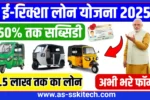
Introduction
The Government of India has launched various welfare schemes aimed at empowering women, especially from economically weaker sections. One such commendable initiative is the Free Sewing Machine Yojana, also known as the Free Silai Machine Yojana. This scheme is designed to provide free sewing machines to eligible women across the country to help them generate a source of income from home. By enabling skill-based self-employment, the scheme not only supports women financially but also fosters a sense of dignity and independence.
Objective of the Scheme
The primary objective of the Free Sewing Machine Yojana is to:
- Promote self-employment among underprivileged women.
- Empower women to become financially independent.
- Encourage home-based work for women in rural and semi-urban areas.
- Reduce poverty by generating livelihood opportunities at the grassroots level.
By offering a simple yet effective tool – a sewing machine – the government aims to uplift women and improve their quality of life.
Benefits of the Free Silai Machine Yojana
The scheme offers several benefits to women, especially those from marginalized communities:
- Employment Opportunity: Sewing is a skill that many women possess. By providing them with a sewing machine, they can start tailoring work from home, such as stitching clothes, school uniforms, or household items like pillow covers and curtains.
- Financial Independence: Women can earn a regular income by taking up stitching assignments, thus reducing dependency on others.
- Home-based Work: This scheme supports women who cannot leave their homes due to family responsibilities, especially in rural or conservative areas.
- Skill Development: Many states also offer basic tailoring training along with the machine to enhance women’s skills and increase the quality of their work.
- Boost to Local Economy: Encouraging small-scale work helps stimulate the local economy and supports other allied businesses like fabric, thread, and accessory suppliers.
Eligibility Criteria
Not every woman is automatically eligible for the scheme. The government has set certain eligibility conditions:
- Age Limit: Women applicants must be between 20 to 40 years old (some states may allow up to 45 years).
- Income Limit: The annual family income should not exceed ₹12,000 to ₹15,000, depending on state guidelines.
- Marital Status: Both married and widowed/divorced women are eligible.
- Nationality: Only Indian citizens can apply.
- Preference Groups: Priority is given to women from Scheduled Castes (SC), Scheduled Tribes (ST), Other Backward Classes (OBC), and economically backward sections.
States Implementing the Scheme
While the scheme is promoted at the national level, it is implemented by various state governments individually. Some of the states that actively participate in the Free Silai Machine Yojana include:
- Gujarat
- Maharashtra
- Haryana
- Rajasthan
- Uttar Pradesh
- Madhya Pradesh
- Tamil Nadu
Each state may modify or rename the scheme as per their local policies, but the core idea remains the same.
Documents Required
To apply for the Free Sewing Machine Yojana, the following documents are generally required:
- Aadhar Card (identity proof)
- Income Certificate
- Age Proof (birth certificate, school certificate)
- Residence Certificate
- Caste Certificate (if applicable)
- Passport-size photographs
- Mobile number
It’s important to note that original documents and photocopies may be required during verification.
How to Apply
The application process may differ slightly across states, but here is the general step-by-step procedure:
Offline Application
- Visit the concerned government office (such as Women and Child Development Department or Panchayat Office).
- Collect the application form for the Free Sewing Machine Scheme.
- Fill out the form carefully with personal, income, and address details.
- Attach the necessary documents like Aadhar, income proof, and photographs.
- Submit the form to the concerned officer.
- After verification, selected candidates will receive a sewing machine either at the office or through a local distribution camp.
Online Application (Where Available)
Some state governments offer online application facilities. The steps are:
- Visit the official state portal (e.g., https://india.gov.in or relevant state website).
- Navigate to the “Schemes” or “Welfare Programs” section.
- Search for the Free Sewing Machine Yojana.
- Fill the online application form and upload scanned documents.
- Submit the form and note the reference number for future tracking.
Once the application is approved, beneficiaries are notified through SMS or call.
Monitoring and Implementation
The scheme is monitored by state departments such as the Department of Social Welfare, Women Empowerment, or Rural Development. Some states collaborate with NGOs or Self-Help Groups (SHGs) for smooth distribution and training support.
Challenges
While the scheme is well-intentioned, a few challenges have been observed:
- Limited Awareness: Many women are unaware of the scheme, especially in remote villages.
- Corruption or Delays: In some areas, there are delays or unofficial charges that reduce the scheme’s effectiveness.
- Limited Machines: Due to budget constraints, not all eligible women may receive machines in the first round.
However, with better outreach, digital inclusion, and transparency, these issues can be gradually resolved.
Success Stories
Across various states, many women have benefited from the scheme. Here are a few examples:
- Rita Devi from Bihar: A widow, she now stitches school uniforms and earns ₹5,000–₹7,000 per month.
- Lata from Madhya Pradesh: With her free machine, she opened a tailoring shop in her village and even trained five other women.
- Saira Bano from Rajasthan: After receiving the machine, she started making embroidered suits and sells them online through WhatsApp and Instagram.
These stories reflect how a small initiative can create a ripple effect in empowering entire communities.

Conclusion
The Free Sewing Machine Yojana is a powerful step toward women’s empowerment and rural employment. By providing the basic tool for self-reliance, the government is enabling lakhs of women to take charge of their economic future. To make the scheme even more impactful, more awareness campaigns, faster processing, and extended training support should be introduced. With such efforts, India can truly progress toward inclusive and sustainable development.
